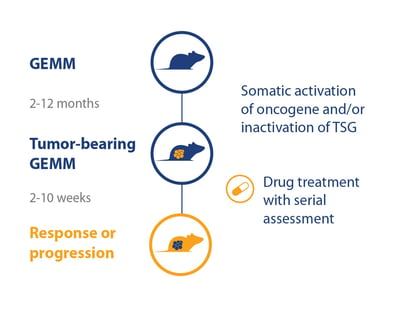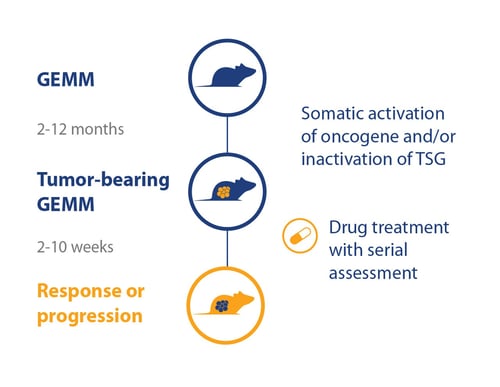Genetically Engineered Mouse Models (GEMM) for I/O Studies

Led largely by the growth in immuno-oncology research, older immunocompetent model use continues to rise. These models include syngeneics, reviewed recently in this post, and genetically engineered mouse models (GEMM).
Dominant Oncogenes or Knocked Out Tumor Suppressor Genes cause Tumor Development
 GEMM were first developed back in the 1980s, and are proving to be a useful tool once again for immunotherapy assessment.
GEMM were first developed back in the 1980s, and are proving to be a useful tool once again for immunotherapy assessment.
The first transgenic mice were developed after it was shown that cloned genes could be integrated into mice genomes in a reproducible fashion. Initially, dominant oncogenes were expressed in GEMM, which results in spontaneous tumor formation. The first transgenic mouse was dubbed the “oncomouse” and expressed the specific activated oncogene v‐HRas under the control of a mammary-specific promoter (MMTV).
Moving into the early 1990s, gene knockout was perfected, allowing the creation of GEMM which lacked tumor suppressor genes which also results in tumor development.
Over the years, GEMM have provided a wealth of knowledge for both basic cancer research and translational oncology. This blog takes a look at GEMM main strengths and weaknesses, and major uses within the increasing number of I/O models.
Spontaneous Tumors mimic Primary Human Tumor Growth
The obvious key feature of GEMM for use in immunotherapy assessment is their fully competent murine immunity and comprehensive mouse stroma. Another useful feature is the way tumors develop – arising spontaneously in the mouse, rather than being introduced to the mouse.
This means that tumor growth mimics primary human tumor growth, accompanied by features such as profound immune suppression and escape from immune surveillance. GEMM can therefore be used to interrogate the complete process of cancer progression and assess where stimulating the immune system might be most beneficial.
Large Model Collections cover Many Cancer Indications
GEMM tend to be well-characterized following many years of study, in contrast with newer models such as humanized mice. There are large collections of GEMM available covering many common cancer indications e.g. lung, prostate, breast, colon, and pancreatic cancers, compared with syngeneic models, for example, for which there are a limited number of cell lines.
Well Suited to Mechanism of Action (MOA) Studies
The main use for GEMM is intrinsically linked to how tumors develop, and the platform limitations. The spontaneous nature of tumors lends the model to being ideal for mechanism of action studies, but less useful for efficacy evaluation. In each individual mouse the disease will progress at a different speed, and 100% penetrance can’t be achieved. There’s also a latency period before tumor development which can be extremely long.
Complex and Costly for Efficacy Studies
This creates complications for GEMM efficacy studies – potentially needing rolling enrolment as each mouse becomes ready at a different time, which leads to difficulty in estimating treatment duration and determining readouts. Large cohorts of mice and long breeding/study times all contribute to complex and costly efficacy studies, compared with a more simple murine immunity model such as a syngeneic.
Not all models follow this pattern though, with some proving more useful for efficacy testing. The MMTV-PyVT TG mouse has:
- a high penetrance
- only 5 week latency period
making it more straightforward to use. The model also shows 80-90% metastasis to the lung, making it useful for clinically relevant studies.
Mouse Analogue Evaluation Only
The other main drawback of GEMM is that their biology is mouse not human. This means that human specific immunotherapeutics cannot be tested, unless a mouse orthologue exists to be exploited. Mouse biology can also differ significantly from humans, particularly when using immunotherapies which needs to be taken into account when using this platform. To test human specific agents humanized/drug target humanized models need to be used.
Hopefully this blog has provided an introduction and main reasons why you might choose (or not) to use a GEMM for your study. Further reading can be found on:
- A review on immuno-oncology models in general, including GEMM and the future of next generation models can be found here, Li et al Experimental animal modeling for immuno-oncology.
- A review on GEMM in oncology research: Kersten et al Genetically engineered mouse models in oncology research and cancer medicine
Cite this Article
Jody Barbeau, PhD, (2017) Genetically Engineered Mouse Models (GEMM) for I/O Studies - Crown Bioscience. https://blog.crownbio.com/gemm-immuno-oncology-models


